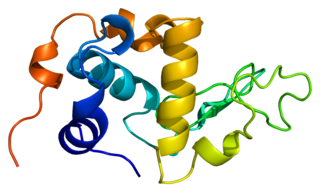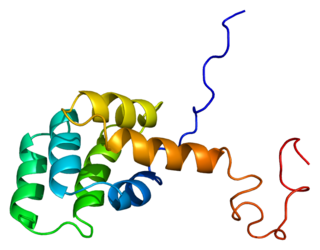Related Research Articles

Apoptosis is a form of programmed cell death that occurs in multicellular organisms. Biochemical events lead to characteristic cell changes (morphology) and death. These changes include blebbing, cell shrinkage, nuclear fragmentation, chromatin condensation, DNA fragmentation, and mRNA decay. The average adult human loses between 50 and 70 billion cells each day due to apoptosis. For an average human child between the ages of 8 and 14, approximately 20–30 billion cells die per day.
Experimental cancer treatments are non-medical therapies intended to treat cancer by improving on, supplementing or replacing conventional methods. Experimental cancer treatments cannot make medical claims. The term experimental cancer treatment could thus be substituted for "non FDA approved cancer treatment."

Proteasomes are protein complexes which degrade unneeded or damaged proteins by proteolysis, a chemical reaction that breaks peptide bonds. Enzymes that help such reactions are called proteases.

Lactalbumin, alpha-, also known as LALBA, is a protein that in humans is encoded by the LALBA gene.

The Fas receptor, also known as Fas, FasR, apoptosis antigen 1, cluster of differentiation 95 (CD95) or tumor necrosis factor receptor superfamily member 6 (TNFRSF6), is a protein that in humans is encoded by the FAS gene. Fas was first identified using a monoclonal antibody generated by immunizing mice with the FS-7 cell line. Thus, the name Fas is derived from FS-7-associated surface antigen.

The death-inducing signaling complex or DISC is a multi-protein complex formed by members of the "death receptor" family of apoptosis-inducing cellular receptors. A typical example is FasR, which forms the DISC upon trimerization as a result of its ligand (FasL) binding. The DISC is composed of the death receptor, FADD, and caspase 8. It transduces a downstream signal cascade resulting in apoptosis.

The BH3 interacting-domain death agonist, or BID, gene is a pro-apoptotic member of the Bcl-2 protein family. Bcl-2 family members share one or more of the four characteristic domains of homology entitled the Bcl-2 homology (BH) domains, and can form hetero- or homodimers. Bcl-2 proteins act as anti- or pro-apoptotic regulators that are involved in a wide variety of cellular activities.

Survivin, also called baculoviral inhibitor of apoptosis repeat-containing 5 or BIRC5, is a protein that, in humans, is encoded by the BIRC5 gene.

Caspase-8 is a caspase protein, encoded by the CASP8 gene. It most likely acts upon caspase-3. CASP8 orthologs have been identified in numerous mammals for which complete genome data are available. These unique orthologs are also present in birds.

X-linked inhibitor of apoptosis protein (XIAP), also known as inhibitor of apoptosis protein 3 (IAP3) and baculoviral IAP repeat-containing protein 4 (BIRC4), is a protein that stops apoptotic cell death. In humans, this protein (XIAP) is produced by a gene named XIAP gene located on the X chromosome.

Caspase-3 is a caspase protein that interacts with caspase-8 and caspase-9. It is encoded by the CASP3 gene. CASP3 orthologs have been identified in numerous mammals for which complete genome data are available. Unique orthologs are also present in birds, lizards, lissamphibians, and teleosts.

ROCK1 is a protein serine/threonine kinase also known as rho-associated, coiled-coil-containing protein kinase 1. Other common names are ROKβ and P160ROCK. ROCK1 is a major downstream effecter of the small GTPase RhoA and is a regulator of the actomyosin cytoskeleton which promotes contractile force generation. ROCK1 plays a role in cancer and in particular cell motility, metastasis, and angiogenesis.

Baculoviral IAP repeat-containing protein3 is a protein that in humans is encoded by the BIRC3 gene.

Diablo homolog (DIABLO) is a mitochondrial protein that in humans is encoded by the DIABLO gene on chromosome 12. DIABLO is also referred to as second mitochondria-derived activator of caspases or SMAC. This protein binds inhibitor of apoptosis proteins (IAPs), thus freeing caspases to activate apoptosis. Due to its proapoptotic function, SMAC is implicated in a broad spectrum of tumors, and small molecule SMAC mimetics have been developed to enhance current cancer treatments.

DNA fragmentation factor subunit alpha (DFFA), also known as Inhibitor of caspase-activated DNase (ICAD), is a protein that in humans is encoded by the DFFA gene.

Deleted in Liver Cancer 1 also known as DLC1 and StAR-related lipid transfer protein 12 (STARD12) is a protein which in humans is encoded by the DLC1 gene.

Baculoviral IAP repeat-containing protein 7 is a protein that in humans is encoded by the BIRC7 gene.
Tumstatin is a protein fragment cleaved from collagen that serves as both an antiangiogenic and proapoptotic agent. It has similar function to canstatin, endostatin, restin, and arresten, which also affect angiogenesis. Angiogenesis is the growth of new blood vessels from pre-existing blood vessels, and is important in tumor growth and metastasis. Angiogenesis is stimulated by many growth factors, the most prevalent of which is vascular endothelial growth factor (VEGF).

Withaferin A is a steroidal lactone, derived from Acnistus arborescens, Withania somnifera and other members of family Solanaceae. It has been traditionally used in ayurvedic medicine. It is the first member of the withanolide class of ergostane type product to be discovered. This natural product has wide range of pharmacological activities including cardioprotective, anti-inflammatory, immuno-modulatory, anti-angiogenesis, anti-metastasis and anti-carcinogenic properties.
Anticancer genes are genes that, when ectopically overexpressed, specifically destroy tumour cells without harming normal, untransformed cells. This cellular destruction can be due to a variety of mechanisms, such as apoptosis, mitotic catastrophe followed by apoptosis or necrosis, and autophagy. Anticancer genes emerged from studies on cancer cells in the late 1990s. Currently, there have been 291 anticancer genes discovered in the human genome. In order to be classified as an anticancer gene, the gene must have base substitutions leading to missense amino-acid changes, deletions, or insertions leading to frameshifts that alter the protein the gene codes for, increases and decreases in copy-number increases, or gene rearrangements leading to their deregulation.
References
- 1 2 3 4 Ho C S, J; Rydström, A; Trulsson, M; Bålfors, J; Storm, P; Puthia, M; Nadeem, A; Svanborg, C (Oct 2012). "HAMLET: functional properties and therapeutic potential". Future Oncology (London, England). 8 (10): 1301–13. doi:10.2217/fon.12.122. PMID 23130929.
- 1 2 Håkansson A, Zhivotovsky B, Orrenius S, Sabharwal H, Svanborg C (August 1995). "Apoptosis induced by a human milk protein". Proc. Natl. Acad. Sci. U.S.A. 92 (17): 8064–8. Bibcode:1995PNAS...92.8064H. doi: 10.1073/pnas.92.17.8064 . PMC 41287 . PMID 7644538.
- ↑ Svensson M, Håkansson A, Mossberg AK, Linse S, Svanborg C (April 2000). "Conversion of alpha-lactalbumin to a protein inducing apoptosis". Proc. Natl. Acad. Sci. U.S.A. 97 (8): 4221–6. Bibcode:2000PNAS...97.4221S. doi: 10.1073/pnas.97.8.4221 . PMC 18203 . PMID 10760289.
- ↑ Gustafsson L, Hallgren O, Mossberg AK, Pettersson J, Fischer W, Aronsson A, Svanborg C (May 2005). "HAMLET kills tumor cells by apoptosis: structure, cellular mechanisms, and therapy". J. Nutr. 135 (5): 1299–303. doi:10.1093/jn/135.5.1299. PMID 15867328.
- ↑ Pettersson-Kastberg J, Aits S, Gustafsson L, Mossberg A, Storm P, Trulsson M, Persson F, Mok KH, Svanborg C (2009). "Can misfolded proteins be beneficial? The HAMLET case". Ann. Med. 41 (3): 162–76. doi:10.1080/07853890802502614. PMID 18985467. S2CID 31198109.
- ↑ Halskau O, Underhaug J, Frøystein NA, Martínez A (June 2005). "Conformational flexibility of alpha-lactalbumin related to its membrane binding capacity". J. Mol. Biol. 349 (5): 1072–86. doi:10.1016/j.jmb.2005.04.020. PMID 15913646.
- ↑ Svanborg C, Agerstam H, Aronson A, Bjerkvig R, Düringer C, Fischer W, Gustafsson L, Hallgren O, Leijonhuvud I, Linse S, Mossberg AK, Nilsson H, Pettersson J, Svensson M (2003). "HAMLET kills tumor cells by an apoptosis-like mechanism--cellular, molecular, and therapeutic aspects". Adv. Cancer Res. Advances in Cancer Research. 88: 1–29. doi:10.1016/S0065-230X(03)88302-1. ISBN 9780120066889. PMID 12665051.
- ↑ Mok KH, Pettersson J, Orrenius S, Svanborg C (March 2007). "HAMLET, protein folding, and tumor cell death". Biochem. Biophys. Res. Commun. 354 (1): 1–7. doi:10.1016/j.bbrc.2006.12.167. PMID 17223074.
- ↑ Düringer C, Hamiche A, Gustafsson L, Kimura H, Svanborg C (October 2003). "HAMLET interacts with histones and chromatin in tumor cell nuclei". J. Biol. Chem. 278 (43): 42131–5. doi: 10.1074/jbc.M306462200 . PMID 12888554.
- ↑ Brest P, Gustafsson M, Mossberg AK, Gustafsson L, Duringer C, Hamiche A, Svanborg C (December 2007). "Histone deacetylase inhibitors promote the tumoricidal effect of HAMLET". Cancer Res. 67 (23): 11327–34. doi: 10.1158/0008-5472.CAN-07-1153 . PMID 18056459.
- ↑ Aits S, Gustafsson L, Hallgren O, Brest P, Gustafsson M, Trulsson M, Mossberg AK, Simon HU, Mograbi B, Svanborg C (March 2009). "HAMLET (human alpha-lactalbumin made lethal to tumor cells) triggers autophagic tumor cell death". Int. J. Cancer. 124 (5): 1008–19. doi: 10.1002/ijc.24076 . PMID 19048621.
- ↑ Marks, LR; Clementi, EA; Hakansson, AP (2013). "Sensitization of Staphylococcus aureus to Methicillin and Other Antibiotics In Vitro and In Vivo in the Presence of HAMLET". PLOS ONE. 8 (5): e63158. Bibcode:2013PLoSO...863158M. doi: 10.1371/journal.pone.0063158 . PMC 3641093 . PMID 23650551.
- ↑ Mossberg AK, Hou Y, Svensson M, Holmqvist B, Svanborg C (April 2010). "HAMLET treatment delays bladder cancer development". J. Urol. 183 (4): 1590–7. doi:10.1016/j.juro.2009.12.008. PMID 20172551.